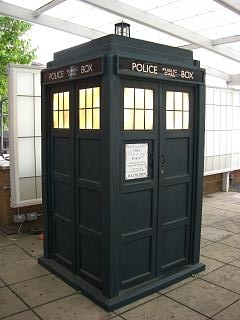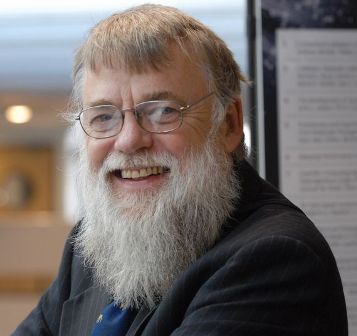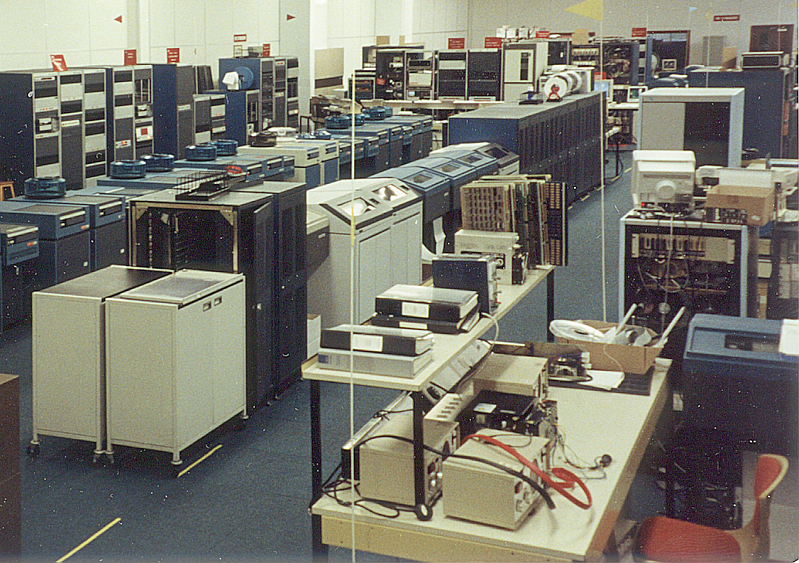|
GEC Series 63
The GEC Series 63 was a 32-bit minicomputer produced by GEC Computers Limited of the UK during the 1980s in conjunction with A.B. Dick in USA. During development, the computer was known as the R Project. The hardware development (under Dick Ruth and Ed Mack) was done in Scottsdale, Arizona whilst the software was the responsibility of GEC in Dunstable, UK. The hardware made early use of pipeline concepts, processing one instruction whilst completing the preceding one. Announced in 1983, two operating systems were to be offered: UX63 and OS6000. UX63 was a Unix port derived from UNIX System III, whereas OS6000 was a port of the OS4000 operating system from the GEC 4000 series (under pressure from the marketing department, concerned about compatibility with its existing user base). Subsequently a version of UNIX System V Release 2 was added - largely to compete with VAX machines which were becoming the fashionable computer of choice amongst academics, concerned about being a ... [...More Info...] [...Related Items...] OR: [Wikipedia] [Google] [Baidu] |
GEC Series 63 Logo
GEC or Gec may refer to: Education * Gedo Education Committee, in Somalia * Glen Eira College, in Caulfield East, Victoria, Australia * Goa Engineering College, India * Government Engineering College (other) * Guild for Exceptional Children, in New York City, US * Gwalior Engineering College, India Other uses * Aleksandar Gec (1928–2008), Serbian basketball player * General Electric Company, a former British engineering conglomerate * General entertainment channel, a type of TV or radio channel * Global Environment Centre, Malaysia * Golden Empire Council, of the Boy Scouts of America * ''Gran Enciclopèdia Catalana'', a Catalan-language encyclopedia * Greater Egyptian Conference, an athletics conference in Illinois, US * Green Electronics Council, US * Grêmio Esportivo Catanduvense, a former Brazilian football club * Grounding electrode conductor * Lufthansa Cargo, a German cargo airline, ICAO code * Mount GEC, in Jasper National Park, Canada * 100 Gecs, a ... [...More Info...] [...Related Items...] OR: [Wikipedia] [Google] [Baidu] |
UNIX System V
Unix System V (pronounced: "System Five") is one of the first commercial versions of the Unix operating system. It was originally developed by AT&T and first released in 1983. Four major versions of System V were released, numbered 1, 2, 3, and 4. System V Release 4 (SVR4) was commercially the most successful version, being the result of an effort, marketed as ''Unix System Unification'', which solicited the collaboration of the major Unix vendors. It was the source of several common commercial Unix features. System V is sometimes abbreviated to SysV. , the AT&T-derived Unix market is divided between four System V variants: IBM's AIX, Hewlett Packard Enterprise's HP-UX and Oracle's Solaris, plus the free-software illumos forked from OpenSolaris. Overview Introduction System V was the successor to 1982's UNIX System III. While AT&T developed and sold hardware that ran System V, most customers ran a version from a reseller, based on AT&T's reference implementation. A s ... [...More Info...] [...Related Items...] OR: [Wikipedia] [Google] [Baidu] |
TARDIS
The TARDIS (; acronym for "Time And Relative Dimension In Space") is a fictional hybrid of the time machine and spacecraft that appears in the British science fiction television series ''Doctor Who'' and its various spin-offs. Its exterior appearance mimics a police box, an obsolete type of telephone kiosk that was once commonly seen on streets in Britain. Paradoxically, its interior is shown as being much larger than its exterior, commonly described as being "bigger on the inside". Due to the significance of ''Doctor Who'' in popular British culture, the shape of the police box is now more strongly associated with the TARDIS than its real-world inspiration. The name and design of the TARDIS is a registered trademark of the British Broadcasting Corporation (BBC), despite the fact that the design was originally created by the Metropolitan Police Service. Name TARDIS is an acronym of "Time And Relative Dimension(s) in Space". The word "Dimension" is alternatively rendered in th ... [...More Info...] [...Related Items...] OR: [Wikipedia] [Google] [Baidu] |
University Of Edinburgh
The University of Edinburgh ( sco, University o Edinburgh, gd, Oilthigh Dhùn Èideann; abbreviated as ''Edin.'' in post-nominals) is a public research university based in Edinburgh, Scotland. Granted a royal charter by King James VI in 1582 and officially opened in 1583, it is one of Scotland's four ancient universities and the sixth-oldest university in continuous operation in the English-speaking world. The university played an important role in Edinburgh becoming a chief intellectual centre during the Scottish Enlightenment and contributed to the city being nicknamed the " Athens of the North." Edinburgh is ranked among the top universities in the United Kingdom and the world. Edinburgh is a member of several associations of research-intensive universities, including the Coimbra Group, League of European Research Universities, Russell Group, Una Europa, and Universitas 21. In the fiscal year ending 31 July 2021, it had a total income of £1.176 billion, of ... [...More Info...] [...Related Items...] OR: [Wikipedia] [Google] [Baidu] |
University Of Edinburgh School Of Informatics
The School of Informatics is an academic unit of the University of Edinburgh, in Scotland, responsible for research, teaching, outreach and commercialisation in informatics. It was created in 1998 from the former Department of Artificial Intelligence, the Centre for Cognitive Science and the Department of Computer Science, along with the Artificial Intelligence Applications Institute (AIAI) and the Human Communication Research Centre. Research in the School of Informatics draws on multiple disciplines. The school is particularly known for research in the areas of artificial intelligence, computational linguistics, systems biology, mathematical logic and theoretical computer science; but also contributes to many other areas of informatics. The School of Informatics was ranked 12th in the world by the QS World University Rankings 2014. As of 2022, the school is ranked 1st in the UK according to ''CSRankings'', 1st in the UK in the latest 2021 Research Excellence Framework (REF) by ... [...More Info...] [...Related Items...] OR: [Wikipedia] [Google] [Baidu] |
Digital Equipment Corporation
Digital Equipment Corporation (DEC ), using the trademark Digital, was a major American company in the computer industry from the 1960s to the 1990s. The company was co-founded by Ken Olsen and Harlan Anderson in 1957. Olsen was president until forced to resign in 1992, after the company had gone into precipitous decline. The company produced many different product lines over its history. It is best known for the work in the minicomputer market starting in the mid-1960s. The company produced a series of machines known as the PDP line, with the PDP-8 and PDP-11 being among the most successful minis in history. Their success was only surpassed by another DEC product, the late-1970s VAX "supermini" systems that were designed to replace the PDP-11. Although a number of competitors had successfully competed with Digital through the 1970s, the VAX cemented the company's place as a leading vendor in the computer space. As microcomputers improved in the late 1980s, especially wit ... [...More Info...] [...Related Items...] OR: [Wikipedia] [Google] [Baidu] |
Systime Computers
Systime Computers Ltd was a British computer manufacturer and systems integrator of the 1970s and 1980s. During the late 1970s and early 1980s, Systime become the second largest British manufacturer of computers, specializing in the minicomputer market. The company was based in Leeds, England, and founded in 1973. Its success was based on selling systems built around OEM components from Digital Equipment Corporation (DEC), and it grew to have over 1,300 employees with turnover peaking around £60 million. Systime was unusual among systems integrators in that it actually manufactured the hardware it sold to customers. A portion of Systime was purchased in 1983 by Control Data Corporation and the company's founder departed. Systime Computers then went through a period of sharp decline, in part due to lawsuits from DEC for intellectual property infringement, and even more so due to charges of violating Cold War-era U.S. export restrictions regarding indirect sales to Ea ... [...More Info...] [...Related Items...] OR: [Wikipedia] [Google] [Baidu] |
Alvey
The Alvey Programme was a British government sponsored research programme in information technology that ran from 1984 to 1990. The programme was a reaction to the Japanese Fifth Generation project, which aimed to create a computer using massively parallel computing/processing. The programme was not focused on any specific technology such as robotics, but rather supported research in knowledge engineering in the United Kingdom. It has been likened in operations to the U.S. Defense Advanced Research Projects Agency (DARPA) and Japan's ICOT. Background During the early 1980s, Japan invited the United Kingdom to become a part of the Fifth Generation Project. In October 1981, a Department of Industry mission to Japan consisting of academics, civil servants and business representatives explored collaboration opportunities and attended the Fifth Generation conference. Informed by negotiations between ICL and Fujitsu conducted to "ensure the survival of ICL", suggesting that collabo ... [...More Info...] [...Related Items...] OR: [Wikipedia] [Google] [Baidu] |
PERQ
The PERQ, also referred to as the Three Rivers PERQ or ICL PERQ, was a pioneering workstation computer produced in the late 1970s through the early 1980s. In June 1979, the company took its very first order from the UK's Rutherford Appleton Laboratory and the computer was officially launched in August 1979 at SIGGRAPH in Chicago. It was the first commercially produced personal workstation with a Graphical User Interface. The design was heavily influenced by the original workstation computer, the Xerox Alto, which was never commercially produced. The origin of the name "PERQ" was chosen both as an acronym of "Pascal Engine that Runs Quicker," and to evoke the word '' perquisite'' commonly called ''perks'', that is employee additional benefits. The workstation was conceived by six former Carnegie Mellon University alumni and employees, Brian S. Rosen, James R. Teter, William H. Broadley, J. Stanley Kriz, Raj Reddy and Paul G. Newbury, who formed the startup Three Rivers Compute ... [...More Info...] [...Related Items...] OR: [Wikipedia] [Google] [Baidu] |
HLH Orion
The Orion was a series of 32-bit super-minicomputers designed and produced in the 1980s by High Level Hardware Limited (HLH), a company based in Oxford, UK. The company produced four versions of the machine: * The original Orion, sometimes referred to as the "Microcodeable Orion". * The Orion 1/05, in which the microcodeable CPU was replaced with the much faster Fairchild Clipper RISC C-100 processor providing approximately 5.5 MIPS of integer performance and 1 Mflop of double precision floating point performance. * The Orion 1/07 which offered approximately 33% greater performance over the 1/05 (7.3 MIPS and 1.33 Mflops). * The Orion 1/10 based on a later generation C-300 Clipper from the Advanced Processor Division at Intergraph Corporation that required extensive cooling. The Orion 1/10 offered a further 30% improvement for integer and single precision floating point operations and over 150% improvement for double precision floating point (10 MIPS and 3 Mflops). All four mac ... [...More Info...] [...Related Items...] OR: [Wikipedia] [Google] [Baidu] |
GEC 4000 Series
The GEC 4000 was a series of 16/32-bit minicomputers produced by GEC Computers Ltd in the United Kingdom during the 1970s, 1980s and early 1990s. History GEC Computers was formed in 1968 as a business unit of the GEC conglomerate. It inherited from Elliott Automation the ageing Elliott 900 series, and needed to develop a new range of systems. Three ranges were identified, known internally as Alpha, Beta, and Gamma. Alpha appeared first and became the GEC 2050 8-bit minicomputer. Beta followed and became the GEC 4080. Gamma was never developed, so a few of its enhanced features were consequently pulled back into the 4080. The principal designer of the GEC 4080 was Dr. Michael Melliar-Smith and the principal designer of the 4060 and 4090 was Peter Mackley. The 4000 series systems were developed and manufactured in the UK at GEC Computers' Borehamwood offices in Elstree Way. Development and manufacture transferred to the company's new factories in Woodside Estate, Dunstabl ... [...More Info...] [...Related Items...] OR: [Wikipedia] [Google] [Baidu] |
32-bit
In computer architecture, 32-bit computing refers to computer systems with a processor, memory, and other major system components that operate on data in 32-bit units. Compared to smaller bit widths, 32-bit computers can perform large calculations more efficiently and process more data per clock cycle. Typical 32-bit personal computers also have a 32-bit address bus, permitting up to 4 GB of RAM to be accessed; far more than previous generations of system architecture allowed. 32-bit designs have been used since the earliest days of electronic computing, in experimental systems and then in large mainframe and minicomputer systems. The first hybrid 16/32-bit microprocessor, the Motorola 68000, was introduced in the late 1970s and used in systems such as the original Apple Macintosh. Fully 32-bit microprocessors such as the Motorola 68020 and Intel 80386 were launched in the early to mid 1980s and became dominant by the early 1990s. This generation of personal computers coincided ... [...More Info...] [...Related Items...] OR: [Wikipedia] [Google] [Baidu] |






